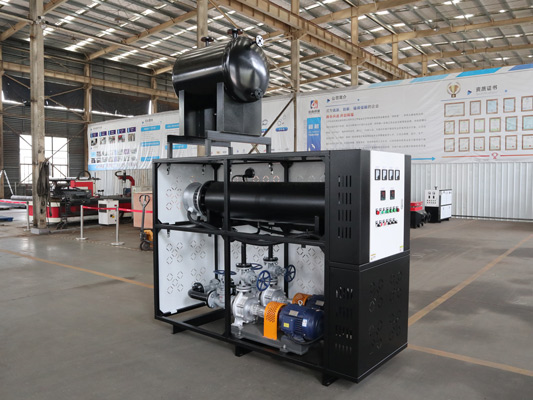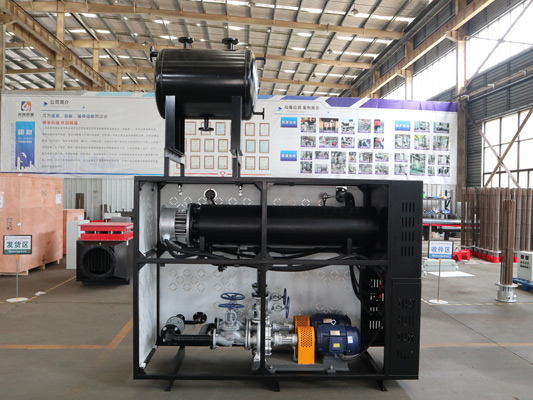- In thermal oil furnace system, the choice of pump directly affects the reliability, stability and operating cost of the system. Single pump and dual pump (usually refers to "one for use and one for standby" or parallel design) have their own advantages and disadvantages. The following analyzes their advantages and disadvantages from multiple dimensions so that you can choose according to actual needs:

1. Single pump system (single circulation pump)
Advantages:
1. Simple structure and low initial investment. The single pump system does not require additional pumps, control valves and switching circuits. The cost of equipment procurement, pipeline installation and control system is significantly reduced, which is especially suitable for small thermal oil furnaces or scenarios with limited budgets.
2. Small space occupation and convenient maintenance. The system layout is compact, reducing the space requirements of the pump room or equipment room; only a single pump needs to be paid attention to during maintenance, with a small number of spare parts and simple maintenance operations, which is suitable for occasions with limited maintenance resources.
3. Controllable energy consumption (low load scenario) If the system load is stable and low, the single pump can match the appropriate power to avoid redundant energy consumption when the dual pumps are running (especially under non-full load conditions).
Disadvantages:
1. Low reliability and high downtime risk. Once a single pump fails (such as mechanical seal leakage, bearing damage, motor overload, etc.), the heat transfer oil circulation is immediately interrupted, resulting in overheating and carbonization of the heat transfer oil in the furnace, and even equipment damage or safety hazards, seriously affecting continuous production.
2. Unable to flexibly adapt to load fluctuations. When the system heat load suddenly increases (such as multiple heat-using equipment starts at the same time), the flow and pressure of a single pump may not meet the demand, resulting in delayed or unstable temperature control.
3. Maintenance requires shutdown, affecting production. When a single pump is maintained or replaced, the entire heat transfer oil system must be stopped. For 24-hour continuous production scenarios (such as chemical and food processing), the downtime loss is large.

- 2. Dual pump system ("one in use and one in standby" or parallel design)Advantages:1. High reliability, ensuring continuous operation
◦ One in use and one in standby mode: When the operating pump fails, the standby pump can be immediately started through an automatic switching device (such as pressure sensor linkage) to avoid system shutdown. It is suitable for scenarios with high continuity requirements (such as petrochemical and pharmaceutical production lines).
◦Parallel operation mode: The number of pumps that can be turned on can be adjusted according to the load (such as 1 pump at low load and 2 pumps at high load), and the flow demand can be flexibly matched to ensure stable temperature control.
1. Convenient maintenance and reduced downtime The standby pump can be inspected or maintained in the running state without interrupting the system; even if the running pump fails, it usually takes only a few seconds to a few minutes to switch to the standby pump, which greatly reduces production losses.
2. Adapt to high load and fluctuation scenarios When the two pumps are connected in parallel, the maximum flow rate is twice that of a single pump, which can meet the needs of large thermal oil furnaces or systems with large thermal load fluctuations (such as alternating heat use in multiple processes), avoiding the decrease in heating efficiency due to insufficient flow.
3. Extend the service life of the pump The one-in-one-standby mode can make the two pumps wear evenly by rotating the pumps at regular intervals (such as switching once a week), reducing the fatigue loss of a single pump during long-term operation and reducing the maintenance frequency.

- Disadvantages:
1. High initial investment requires the purchase of an additional pump, supporting pipelines, valves (such as check valves, switching valves), control cabinets and automatic switching systems. The overall cost is 30%~50% higher than that of a single pump system, especially for small systems.
2. High system complexity, increased installation and maintenance costs. The dual-pump system requires a more complex pipeline layout (such as parallel pipeline balance design), which may increase leakage points; the control logic (such as automatic switching logic, overload protection) needs to be finely debugged, and the status of both pumps needs to be paid attention to during maintenance, and the types and quantities of spare parts increase.
3. Energy consumption may be higher (some working conditions). If the system runs at low load for a long time, the simultaneous opening of the two pumps may cause "big horses pulling small carts", the pump efficiency decreases, and the energy consumption is higher than that of a single pump; at this time, it is necessary to optimize through frequency conversion control or single pump operation, but it will increase additional costs.
4. The large space required requires the installation location of two pumps to be reserved, and the space requirements for the pump room area or equipment room increase, which may not be friendly to scenarios with limited space (such as renovation projects).
3. Selection suggestions: Decision based on application scenarios
Scenarios where single pump system is preferred:
• Small thermal oil furnace (e.g. thermal power <500kW), stable heat load and non-continuous production (e.g. intermittent heating equipment that starts and stops once a day).
• Scenarios where reliability requirements are not high, short-term shutdown for maintenance is allowed, and shutdown losses are small (e.g. laboratory equipment, small heating devices).
• Strictly limited budget, and the system has backup measures (e.g. temporary external backup pump).
Scenarios where dual pump system is preferred:
• Large thermal oil furnace (thermal power ≥1000kW), or production lines that need to run continuously for 24 hours (e.g. chemical reactors, food baking lines).
• Scenarios where temperature control accuracy is high and temperature fluctuations due to pump failure are not allowed (e.g. fine chemicals, pharmaceutical synthesis).
• Systems with large thermal load fluctuations and frequent flow adjustments (e.g. multiple heat-using equipment are started alternately).
• Scenarios where maintenance is difficult or shutdown losses are high (e.g. outdoor remote equipment, offshore platforms), automatic switching function can reduce manual intervention.
If you want to know more about our product, please contact us!
Post time: Jun-06-2025




